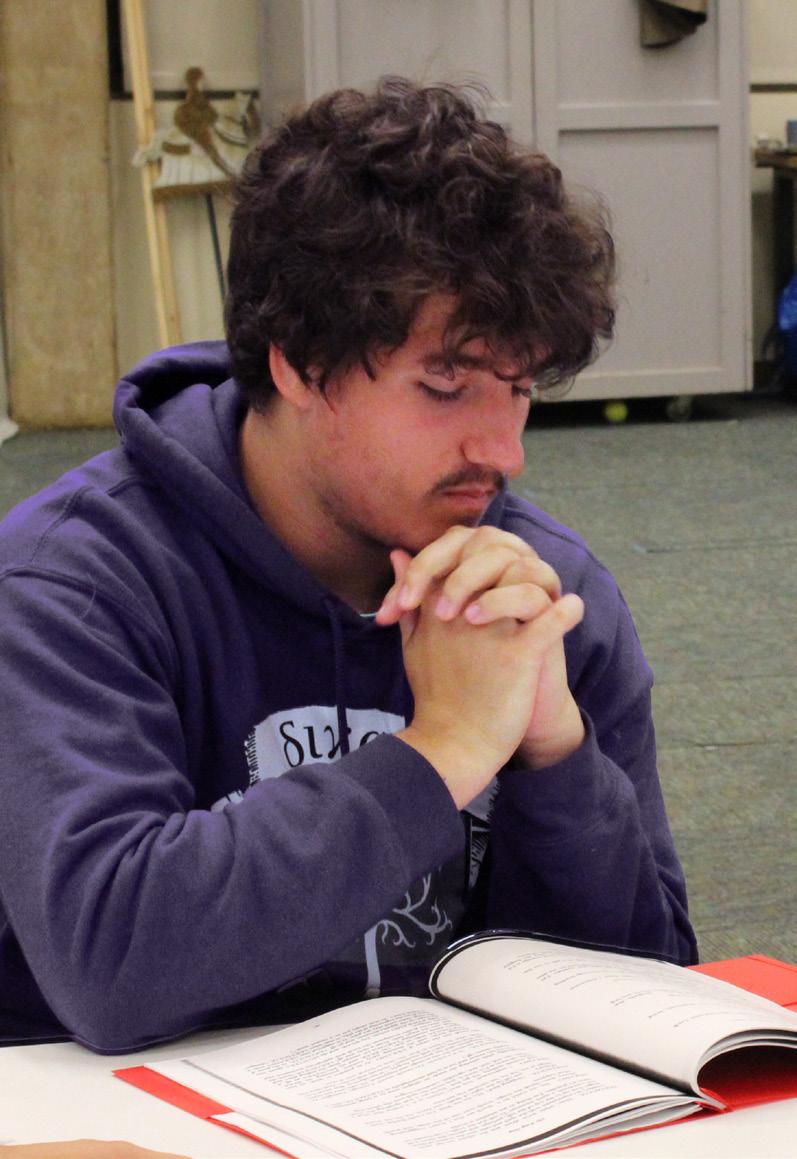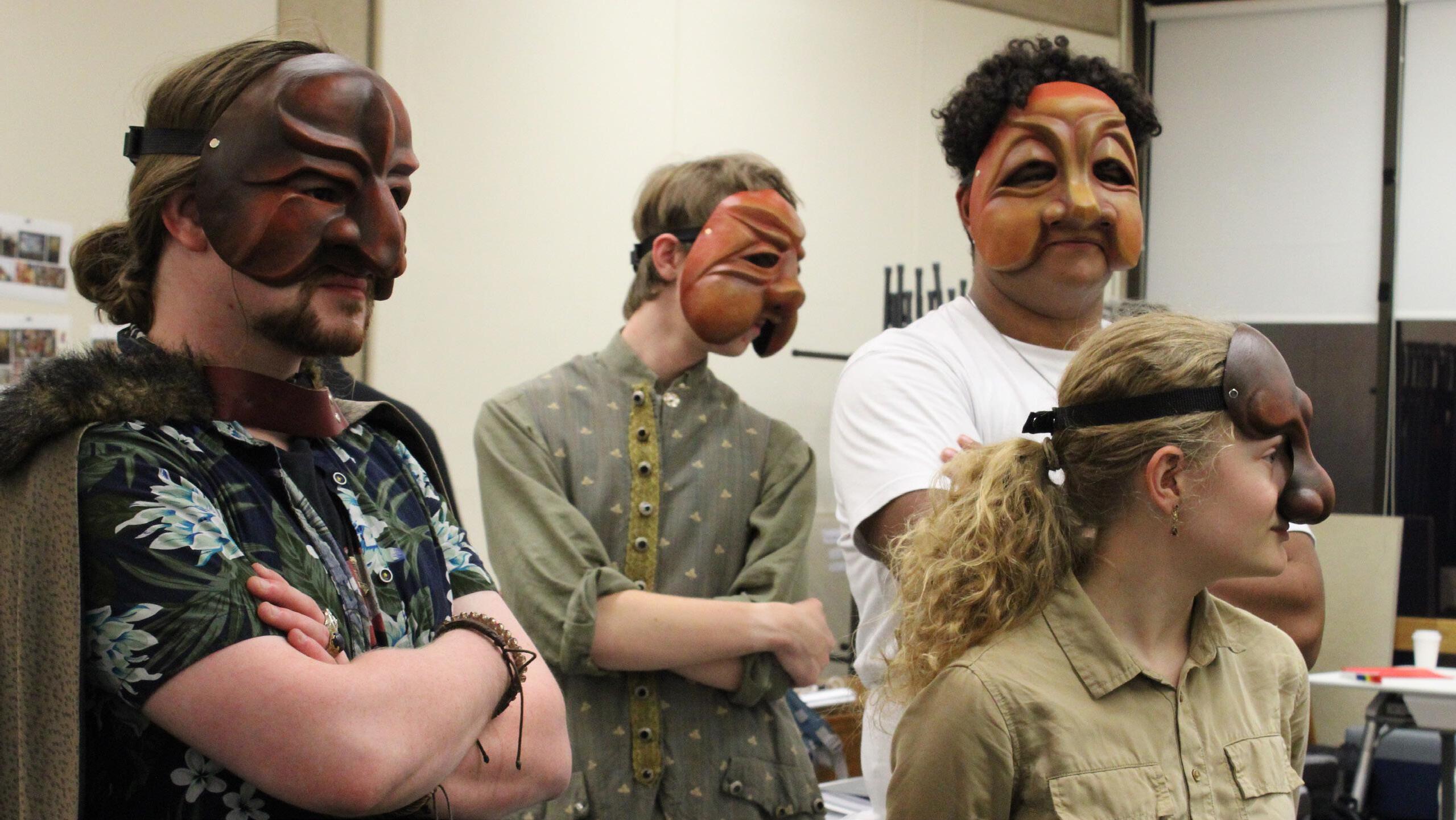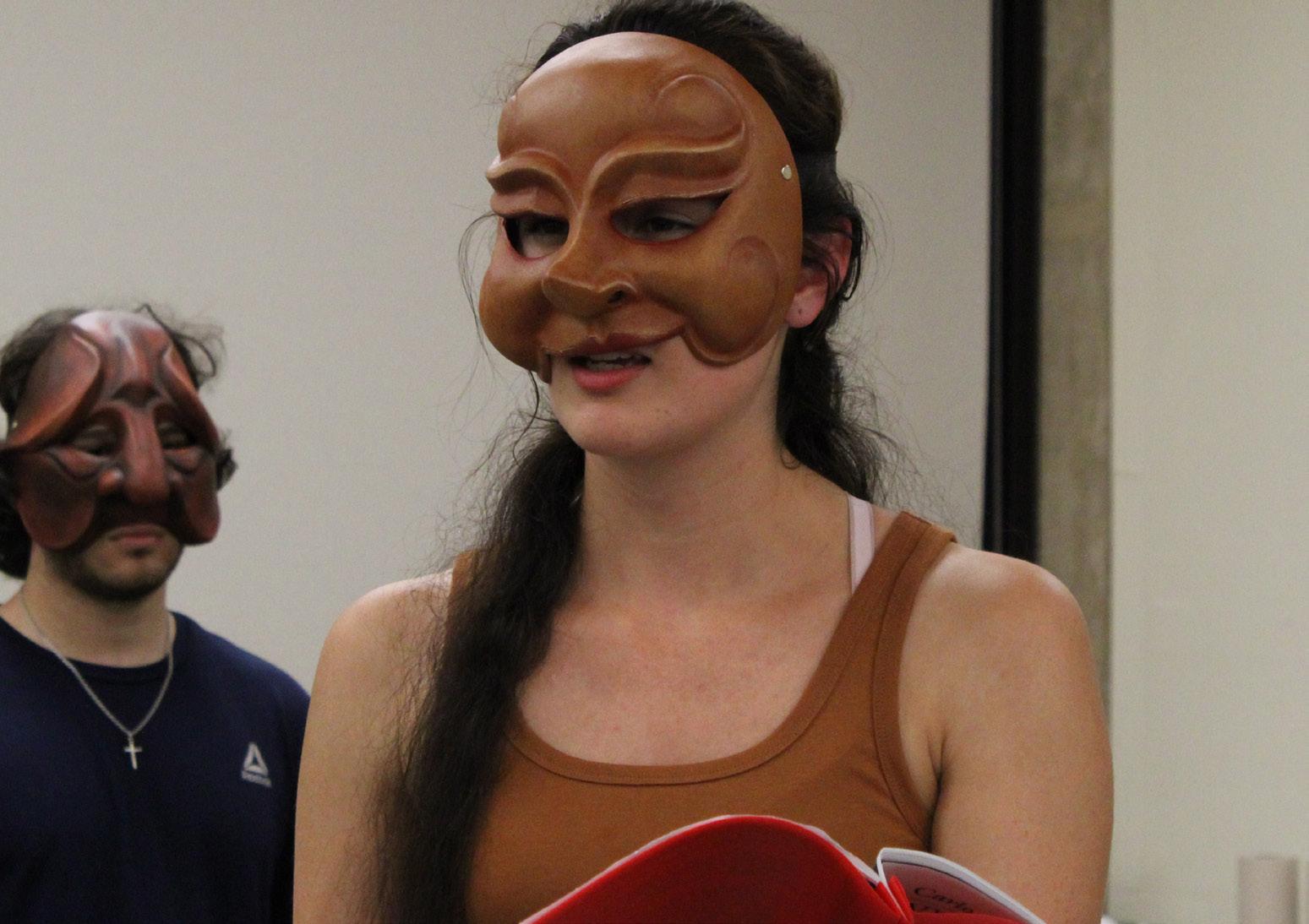




It’s hard to believe, but this issue of OnStage begins our 10th volume—10 years! A credit to all the students whose tireless efforts have created what is now a rich part of the Drama Department’s legacy and a key contribution to the university community we are so privileged to serve. My hope is that OnStage will continue to provide a springboard to richer conversations and engagement with our major productions each semester and the Senior Studios.
This fall, we continue to present our productions on what we now fondly call “The Temp,” our thrust playing space inside the Drama Building. This semester, I am directing Carlo Gozzi’s The King Stag, written in 1762. Known for its focus on the actor and on improvisation, Commedia dell’Arte was Italy’s first real professional theatre. Building on this rich cultural heritage, Gozzi creates a joyous comedy married to a world of dynamic theatricality, heart, and ultimately a celebration of life itself. A unique but vital element of Commedia Dell’arte is the full embrace of archetype and masks in performance. This stands in stark contrast to our contemporary preference in performance style toward realism. This shift in style has been both a challenge and inspiration for our student actors while we work to bring this glorious, rich, and funny theatrical tradition to our audiences.
In this issue of OnStage , you will find illuminating articles which shed light on the dynamic process of creation over the course of the semester to bring Gozzi to life. We also preview our two Senior Studios, directed by senior Drama majors, Sienna Abbott and Braden Barber. I hope you enjoy this, our 10th volume of OnStage , and as always—see you at the theatre!

Kyle Lemieux, Drama Department Chair
Commedia as a New Challenge: Interview with The King Stag Actors
Biography of Carlo Gozzi
Metaphysical Unity: Overview of The King Stag
What is Commedia?: Origins and Evolutions
Heads Held High: Masks in Commedia
Costume and Puppet Designs
Scene Shop Innovations
Guest Artist Workshop: Trey Lyford
Pantalone Unmasked: Interview with Mary Carlin
The Flattering Word: Faith and Theater
Ways and Means: Theater at Full Value
Meet the Cast and Management
Contributing
Writers:
Photography:
Layout
Editors:
Edtor-inChief:
Centerfold:

by Kate Pioch
KP: Would you please briefly introduce yourselves, as well as your character and what your character wants?
BT: I’m Ben Thomas. I’m a senior Drama major. I play Tartaglia. What he wants is power and Angela.
BB: I’m Braden Barber, senior Drama-English major. I play King Deramo, and what Deramo wants most is knowledge. He certainly wants to be with Angela. He certainly wants to be a good king. He wants to be just, but I think his root want is knowledge of all that.
LG: I’m Lucy Gallagher, a junior Drama-English major. I’m playing Angela, and I think what she wants is to be happy with Deramo.
CM: I’m Christian Marin. I am a freshman Drama major. I play Smeraldina, and ultimately I feel like she just wants to be loved.
KP: This sort of play is very different from usual plays. How is working in this Commedia style different from working in any other play or in your other work?
BB: There’s a real learning curve to it actually because many of the things you instill in yourself as an actor you have to get rid of. You have to really focus on how you hold your body and ensure that it matches the mask be -
cause you have less of your upper face to express yourself with. An example for Deramo would be a kingly posture, just never hunching.
BT: It’s really interesting because a lot of what we learn at UD acting-wise is Stanislavskian, all interior. It’s about [how] the work you do on the interior affects the exterior. That was what we would do with The Seagull . But it’s the opposite. The body is where it all comes from. [U]sually you let your interior inform the exterior, but here the exterior informs the interior. That’s really hard to do. Heavy learning curve, heavy learning curve.
LG: It’s hard because a lot of it has to do with arms and upper body and where your center is, and it’s hard to not exaggerate it too much or in the wrong way. Finding a medium where it’s not exaggerated but will still read very clearly—that’s been hard for me.
CM: We’ve been messing with different ideas of who Smeraldina is. Originally it comes very naturally to play Smeraldina as a seductive lady. So last night we integrated some smoking, some smoking breath. It was very interesting.
KP: How does working in a mask change the way that you act, if at all?
BT: You can’t look down. Otherwise, you lose the bottom half of your face, also the mask itself. I have to look
up when I’m thinking, rather than look down or to the side. I put on Braden’s mask—we switch masks halfway through the show—and I found that I can’t see out of his. The eyes are too high, so I either have to look down to see, which I can’t do, or I look up through the nostrils. It’s really funny for the people in the room to watch.
BB: Visibility is a huge thing to get past. In the end, it’s so delightful, and the masks are so delightful. There’s a lot of character in those faces. None of them are perfectly even, symmetrical. They’re all very distinct, in the nose shapes, and maybe one eye is a little higher than the other in a way that gives it a personality beyond being just a facial covering. That’s been a real privilege to work with.
LG: It’s fun for me to act with a mask, and hard because I love to use my eyes and my eyebrows to express things. It does make it more about the body and your mouth, and you have to articulate your words more, which is difficult. But it’s also more fun because it feels more like you’re putting on somebody else.
BB: There’s a wonderful anonymity to that.
CM: I noticed that you have to push the words beyond where you normally would. I’m fairly decent at projecting my voice, but in the mask it’s almost like you have to do it even more.
BT: We have to learn new tricks on the fly because there’s no subtlety here. The headline of Commedia should be “No subtlety allowed.” I do a hunch-over slightly, and someone says, “Nope, it’s gotta be more!” Okay, well, now I feel silly. What do you mean? Conquering the silliness is half the battle.
KP: What does Commedia allow The King Stag to say that other plays cannot do?
BB: I can speak for Deramo’s relationship to the play, which is “What is the making of a man? What makes you who you are?” It’s a question Commedia asks due to the masks, putting on a physicality far from your own. Deramo, when he’s trapped in [stag] form, has this really low moment. He can pass into the body of an old man. He’s human again, but he doesn’t feel like himself. He says, “I am Deramo, but am I my true self?” How much does a physicality make you you ? I think that’s a through line of the play.
LG: For Angela, it’s strange because most of the scenes I’m in feel like a tonal shift from the rest of the scenes because they feel more serious. The fact that it’s Commedia and that I’m wearing a mask and that I have to take on a specific character type still helps it because [they] make it feel less realistic and more emotionally exterior. So it does help it in some ways.
CM: [ Commedia ] allows the whole group to be able to go beyond what normally is onstage because everything is so exaggerated. You lose the face, but you gain so much more physicality to it that you have to go all the way. You can’t go in between. For Smeraldina, she doesn’t have a problem with that. She goes all the way 110%, whether she shouldn’t or she should. It helps provide a “this is who she is” type of feeling to her.
BB: I feel willing to go silly, willing to go bigger. [The mask is] more than costuming. To give something that adds to yourself shifts your focus away from yourself. Obviously you’re still there, present and acting, but the mask gives you something to draw from.
LG: [The play] does draw on serious themes, but because it’s so absurd and so exaggerated, it does it in a lighthearted way, even if some of it is gross and disgusting. But here you think it’s hilarious.
KP: Do you have an individual example during a rehearsal that was insightful, funny, or something that was collaborative—and why.
BT: The problem is that there’s so many.
BT: An incredible moment of someone going for it and it having the perfect effect was one day in the scene where Smeraldina flirts with Deramo, Christian just came in giving 1000%, and I think Braden was almost more off-put than Deramo was.
CM: That was a lot of fun. I had a lot of fun with the bow. I have to bow to Deramo. Professor Lemieux showed me how to bow, so it was a great moment because he had Allison and Margaret do it properly. Then we just see him going for it, and that was a great little moment.
LG: There’s just lots!
KP: That wraps it up. Thank you so much!






by Eben Treat
KP: Would you please describe the character of Pantalone?
Carlo Gozzi was born into a poor, aristocratic family in Venice on Dec. 13, 1720. In order to support himself, the young count served in the army 1741–1744. This time in the army nurtured Gozzi’s quick and highly sarcastic wit, and after returning to Venice, he applied his (uniquely intense) personality to poetry and playwriting. Gozzi soon joined the Academia die Granelleschi, a literary school dedicated to the preservation of traditional Italian poetic forms.
Gozzi’s dedication to the traditional Commedia dell’Arte led to a rivalry which would become central to his work as a playwright. The rivalry emerged from the growing popularity of the works of Carlo Goldoni, which clashed with the Academia die Granelleschi’s ideals. Goldoni had developed a literary style that mixed Italian Commedia dell’Arte with the realism of the French playwright Molière. Gozzi saw Goldoni’s hybrid works, and those of playwrights like him, as a threat to Italian culture, and they incited a deep rivalry between Gozzi and Goldoni. Gozzi unleashed a series of satirical poems and plays attacking Goldoni’s works. For example, in L’amore delle tre melarance, or The Love of Three Oranges, he characterizes Goldoni as a wicked magician.
This rivalry culminated in 1761 when Goldoni exiled himself from Italy to France. Invigorated by this decision, Gozzi, in the same year, began publishing his sequence of Commedia dell’Arte plays entitled Fiabe, or “Fables.” Each play was a fairytale which addressed the proper performance of poetry and theater, in addition to motifs of loyalty, betrayal, and magic. The style’s use of masks and character archetypes well suited satire and allowed Gozzi to continue to (not so) subtly insert his rivals as petty fairies or villains.
Despite the dwindling popularity of Commedia dell’Arte, Gozzi’s works were widely successful for the remainder of his life. Drawn from his life pursuing drama (in every meaning of the word), the works of Carlo Gozzi were met with lasting success in the rest of Europe and have inspired numerous playwrights and poets.
Beatrice Ellison
Carlo Gozzi’s masterpiece of the Commedia dell’Arte genre, The King Stag, is the story of an imaginary and magical kingdom Serendippo based in 18th century Europe. Grand, sweeping action and expressive characters craft this rich, visual story. This is, of course, the magic of Commedia dell’Arte. Commedia plots are supported by the visual elements of stage plays, with their elaborate special effects and costumes, and the story is just as grand.
Cigolotti begins our play, telling us that five years ago in 1757, his master, the magician Durandarte, had come to Serendippo. As a gift, Durandarte had granted King Deramo some of his power by teaching him two magic spells and giving him a statue that can read the hearts of women and detect lies. For this, Durandarte had been punished by his master, the King of the Fairies, who forced him to assume the form of a parrot for five years.
Five years later, in 1762, King Deramo is searching for a bride. He has interviewed 2,748 women before finding Angela, the only woman who truly loves him. He uses the statue Durandarte gave him to read her heart, and, upon finding no trace of dishonesty, Deramo joyfully accepts Angela as his bride and queen. Tartaglia, however, is enraged by Deramo’s marriage, as all along he had wanted Angela for himself. With his plans spoiled, Tartaglia sets out to usurp Deramo’s place as king and as Angela’s husband.
The suspense of the rest of the story is brought about by characters’ bodies and souls being disunified, and the desire to amend this tension guides the motion of the plot. Durandarte brings justice and harmony back to Serendippo by bringing characters’ souls and bodies into more perfect unity. Deramo, our hero, returns to the body that reflects the beauty of his soul, and Tartaglia receives a deformed body to reflect the ugliness of his soul. In line with the Commedia dell’Arte style, the plot of The King Stag moves forward in broad brushstrokes of metaphysical commentary, embellished with a classic tale of good versus evil.





by David Semga
Commedia dell’Arte means “comedy of professional artists.” Originating in Padua, Italy, mid-16th century, the art form was a reversal of the norms of theater at the time. Unlike previous scripted theater performances, dialogue was improvised, and the form introduced character archetypes, such as the pitiful old man (Pantalone), the clown (Arlecchino, or Harlequin), and the con man (Brighella). Plays of Commedia dell’Arte usually constitute young lovers, or innamorati, and obstacles to their quest for unity. These obstacles take the form of antagonists: an older relative or spouse who lusts for the other of the pair. Then an intelligent or divine servant character, or zanni, intervenes to deal with the evil, and all is well again.
Additionally, Commedia dell’Arte popularized masked performances in theater. Masks enhanced storytelling with spectacle and an emphasis on body movements, rather than facial expressions. More practically, masks distinguished the characters on stage and molded actors into an idealized but realistic version of the characters.
Physical comedy was also a big part of Commedia dell’Arte, and it formed the roots for slapstick. This development of physical comedy popularized the art form among diverse groups of people. Other characteristics of this form included but were not limited to: motifs of adultery, jealousy, battles of wit, and importantly, lazzi.
Lazzi were comedic breaks within a performance of Commedia dell’Arte. The actors would direct their attention toward each other or the audience and perform a memorized action, often with the aim of amusement. Lazzi developed from improvisation into scripted comedic bits. Another important aspect of Commedia dell’Arte was letting audiences in on the game of theater. Since the performances within the medium were improvised and topical, the combination of recognizable characters, lazzi, and sometimes fourth wall breaks made the audience feel as if they were not just watching a story unfold, but as if they were a part of it.
As Commedia dell’Arte solidified in the 17th century, the performances drifted away from improvised content to more scripted scenes, characters, and storylines. Nevertheless, the character archetypes and themes stayed consistent. By the 18th century, Commedia became worldwide due to its eccentric nature, and nobles and even monarchs commissioned performances. Around this time arose great playwrights such as Carlo Gozzi (1720–1806) and one of his most renowned plays, The King Stag (1762).
A masterpiece in the art form, this play depicts the neoclassical era and blends elements of deception, love, tragedy, and burlesque all into one performance.
by Cecilia Andrews
Carlo Gozzi’s The King Stag is unique when it comes to the University of Dallas’ Mainstages. “I’ve never done a play in masks here,” Director Kyle Lemieux reported. “This is my 18th Mainstage, and I’m having a ball experimenting, having fun with both the masks and also doing a show that asks us—both as me as a director and cast as an ensemble of actors—[to use] different muscles.” This fall’s Mainstage challenges audience expectations and actor’s capabilities.
Gozzi, the playwright, wanted his play performed with face masks as a tribute to the art of Italian Commedia. “Gozzi, when he writes [The King Stag] in 1762,” Director Lemieux explained, “is bemoaning the decline of Italians’ interest in Commedia.” Because Commedia performances were almost exclusively improvisational and had no scripts, the actors played as character archetypes with personality-specific masks. This way, different audiences could easily recognize already established characters. Jennifer Meagher at The Metropolitan Museum of Art explained that the tradition of wearing masks comes from ancient Roman comedies, and that most all characters wore masks, with the exception of some characters, including the innamorati. Director Lemiuex said, “[W]e’re doing a play from 1762 that, when it was written, was intentionally backward-looking to
Commedia traditionally has specific costume choices for the stock characters. Aged characters dressed in old fashions while high-class characters, like the innamorati, dressed stylishly. Costumes were colorful and theatrical.
For UD’s production of The King Stag, costume designer Martin Sanchez considered how UD could continue Commedia’s tradition, which resulted in the combination of clothing spanning multiple generations of fashion.
Sanchez and his team have also designed and created custom puppets for the show actors will control onstage. The audience is given the chance to stretch their imaginations and to appreciate the amount of skill and technique the designer and the puppeteers have.
keep a rich cultural tradition alive.” Acting with masks honors this tradition. It honors Gozzi.
“...intentionally backwardlooking to keep a rich cultural tradition alive.”
The Drama Department purchased masks from Jonathan Becker of Theater-Masks.com, an American mask maker, known for his contributions to the theatrical arts. Becker is the founder of the North American Laboratory for the Performing Arts, and he is the co-founder of both Switzerland’s Les Senokrates theater company and Paris’ The Brodeur Brothers. According to his website, his masks are made of painted neoprene, a latex compound estimated to last between 250–300 performances whereby the masks undergo tough usage. Director Lemieux explained: “[W]e wanted to ensure that the department can make use of them in the future.”
UD’s actors have a unique challenge ahead of them. Didi Hopkins of the National Theatre noted that “because they wore half masks, and the mask is fixed, it’s the work that you do with your voice and your body and your emotions that brings the mask to life.” Director Lemieux commented, “We just have to relearn the wheel. So it’s fun! It’s a lot of fun in rehearsals.” With Becker’s masks and Gozzi’s comedy, UD’s Drama Department pushes itself once again to deliver a performance rich with tradition and leave our student actors primed to face the theatrical stage with their heads held high.

Scene and set designer Mark Kirk has created a scaffolding background. The scaffolding is made with stained wood and burlap and is meant to replicate an old, worn-down circus tent.
Attached to the scaffold is a curtain and pulley system. From this pulley system, Kirk will hang four custom-made backdrops. Each backdrop represents a different part of the play and will signal when a scene change occurs.
The scene and set team has created some custom props and special effects for the actors of The King Stag. A custom-made pedestal was built for the character “The Statue,” played by actress Isabel Williams. For the hunting scene, toy guns were designed into old-fashioned muskets.

by Ephraim Robinson
Theater artist, director, and teacher Trey Lyford teaches at the Pig Iron School in Philadelphia, PA. There, he often gives instruction in Commedia dell’Arte. On Oct. 8 and 9, he ran a mask workshop at the University of Dallas for the company of The King Stag.
During Lyford’s workshop, the actors explored the associations that their masked characters might have with certain animals. The evening of Oct. 9 saw the cast cavort around the rehearsal room like dogs, cows, horses, and many other animals. The actors also had to maintain the poise that they needed to make their masks read well for the audience. Finally, Lyford set groups of actors together to improvise scenes. Everyone was laughing. The workshop gave the actors new insights for their performance.
in 2005. Since then, Lyford has continued to work in devised theater, which he believes is “very much conjoined at the hip” with Commedia dell’Arte. Lyford said, “Original Commedia performances were very actor-centered, very actor-generated. There were certainly people who were leading those companies back in the 1600s and mid-to-late 1500s, and those companies were very much actor-generated through improvisation.”
“I believe a character’s inadequacy is a gateway to grace; an inlet to everything that makes us hilarious, heartbreaking, and distinct.”
Lyford played the role of Cigolloti in The King Stag while he studied at the University of California, San Diego, for his MFA (together with Kyle Lemieux and Stefan Novinski). He wrote a play called All Wear Bowlers, which The New York Times gave an acclamatory review
Lyford thinks that the actors are the demiurge of theater. More important than what the author has written is the play of the actors, especially their improvisation. When the actors play, “the audience becomes your partner and playwright,” Lyford said. Commedia dell’Arte recognized the power of the good actor, and because the plays were formed from the actors’ improvisations, the humor was much more zany that way.
The workshop was a great “physical background,” as Lyford called Commedia, and it provided actors with an opportunity to spend time just improvising with the masks.
by Kate Pioch
KP: Would you please describe the character of Pantalone?
MC: Pantalone is the father of the characters Angela and Leandro. He is second in command to the king, Tartaglia being first in command. He is a very earnest and humble old man.
KP: Would you be able to describe Pantelone as the Commedia archetype?
MC: Usually in Commedia, Pantalone is the antagonist because he is the father of the girl and won’t let her get married. He’s usually very miserly, very greedy. And he always wears red pants. But in our production, he’s a very good person, if a little bit talkative. We have a different villain, who wants to get with the girl. [Pantalone] is a comedic character. He’s more like Polonius from Hamlet. Although he has some worldly wisdom, he can get in his own way by being so talkative.
KP: What do archetypes do for Commedia?
MC: For the audience of Commedia it makes them very familiar. You have the mischievous servant, the head honcho, the lovers [who are] the innamorati, Pantelone the greedy father, the foolish young doctor, Il Capitano, who pretends to be brave but he isn’t. So these kinds of archetypes are very basic with basic desires and emotions, but they really help someone relate to the action.
KP: What is it like to play in a mask?
MC: It’s really hard actually because in the Drama Department here, we usually strive for naturalism in our acting. But in this performance, it is way bigger because of the masks. We can’t do a slight eyebrow raise or a slight smirk. It just doesn’t read. You have to show your emotion through the position of your head, the way your arms move, the way your legs are positioned.
KP: What should audiences expect?
MC: It’s a comedy. It’s very funny. It’s very weird. Lots of interesting things happen. It’s a multi-media production because we have puppets, a new kind of idea for the scenery, and the costumes are incredible.



by Lucy Gallagher by Stella Nolen
George Kelly’s fast-paced comedy, The Flattering Word, takes place in a small American town at the turn of the 20th century. The mundane world of Reverend Rigley and his parishioners is shaken by a visit from Mrs. Rigley’s childhood friend, the colorful actor Eugene Tesh. With Tesh’s arrival, Rigley and his parishioners face the realization that theater and their church may be more similar than they thought.
“I chose The Flattering Word,” Director Sienna Abbott said, “for the idea that you could enjoy the show, take pleasure in [...] the comic bits and the delightful characters. But, at the same time, the themes within the play, I feel, are very worthy of reflection.” While The Flattering Word explores deep issues, it maintains a light, comedic tone and occurs in small-scale, mundane life. The audience joins Kelly’s small-town churchgoers in wondering whether a religious person compromises his faith when participating in theater.
Because of the small-community feeling Kelly evokes in his play, The Flattering Word appeals to audiences of all sorts of backgrounds and time periods. Kelly’s play has continually been revived due to its naturalistic and charming tone. “I get to bring it to life a hundred years later [...] for audiences that are used to the digital age,” Sienna said.
A University of Dallas audience has been an exciting challenge for Sienna because the UD community exists in this digital, sensual culture while also desiring real and meaningful experiences, often grounded in religion. Because The Flattering Word centers on the tension between religion and theater, the UD audience will connect with Kelly’s play in a special way, invited intimately to follow Rigley’s struggle with the world of performing arts.
“It’s going to be a lively show,” Sienna shared. “We have a very passionate group of actors from unique backgrounds. [...] My goal is that a piece of everybody is in it.” The Flattering Word is a play for everyone, and Sienna’s production will be fresh and exciting because it is brought to an ideal audience, the UD community. Come and enjoy being challenged with questions of faith and theater!
Ways and Means, written by Noel Coward and directed by Braden Barber, is a delightful comedy that elevates, amuses, and entertains. This one-act play, set in the 1930s, presents the image of a bubbling, glittering world that is not as wealthy as it might seem. “[Coward] wanted to bring back a certain dignity to the one-act play,” said Director Braden Barber, “good one-acts that have the heart of a play without any danger of what [Coward] called ‘technical creaking or overpadding.’” This lack of “overpadding” is evident in Ways and Means’ simple entertainment value without need of moralization.
Ways and Means presents the story of Toby and Stella Cartwright, a young, upper-class, British couple who have overstayed their welcome at a friend’s Riviera hotel and racked up gambling debts in the process. The play centers around the Cartwrights’ scramble to acquire money while saving face in front of their friends. When a chauffeur attempts robbery on them, they find the ways and means to escape their financial bind.
Said Barber, “Ways and Means [...] aside from being just funny and an experiment with the wittiness of the dialogue [...] is at heart about [...] a couple who aren’t the most likable. They fight a lot, they trade insults [...] but in the end, they still are a team.” The couple’s love language consists of insults, used for humor and wit.
The value of the play for playwright and director lies in the pure, simple enjoyment of theater, allied with gentle social commentary. The Cartwrights’ commitment to each other, even in the face of social humiliation and bankruptcy, is especially poignant in today’s divorce culture. Their insults do not drive each other away, but rather are the witty banter of a couple who know each other well and enjoy pushing each other’s buttons, which gives a buoyancy and playfulness to the entire play.
When asked what the audience should walk away with, Barber replied, laughing, “With a smile, hopefully. I want the audience to feel drawn into the story of Toby and Stella Cartwright, even if they may not like them or approve of their actions. But for the audience to have a feeling about the humor, the wittiness of it, then I will be content.”

Sienna Abbott Durandarte, Parrot Senior Drama


Braden Barber Deramo Senior Drama/English



Junior Drama/English








Sophomore Philosophy




